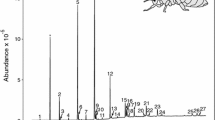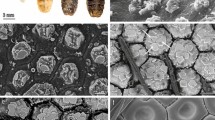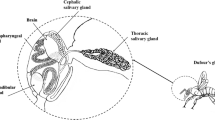Summary
-
1.
The non-extractability of cuticular proteins in formamide and sodium hydroxide, and the elastic modulus, breaking stress, relative stiffness and breaking strain of abdominal cuticle from different developmental stages of adult worker honeybees (Apis mellifera adansonii L.) were examined as a function of developmental age.
-
2.
All of these properties were found to be age dependent.
-
3.
The mechanical properties varied in direct proportion to the amount of sodium hydroxide non-extractable protein, and hence the degree of matrix stabilization.
Similar content being viewed by others
References
Andersen, S.O.: Phenolic compounds isolated from insect hard cuticle and their relationship to the sclerotization process. Insect Biochem.1, 157–170 (1971)
Andersen, S.O.: An enzyme from locust cuticle involved in the formation of cross links fromN-acetyldopamine. J. Insect Physiol.18, 527–540 (1972)
Andersen, S.O.: Comparison between the sclerotization of adult and larval cuticle inSchistocerca gregaria. J. Insect Physiol.19, 1603–1614 (1973)
Andersen, S.O.: Evidence for two mechanisms of sclerotization in insect cuticle Nature251 507–518 (1974)
Andersen, S.O.: Cuticular enzymes and sclerotization in insects. In: The insect integument (ed. H.R. Hepburn), pp. 121–144. Amsterdam: Elsevier 1976a
Andersen, S.O.: Sclerotization in insect cuticle. In: Perspectives in experimental biology, Vol.1 (ed. P. Spencer Davies), pp. 187–190. Oxford: Pergamon Press 1976b
Andersen, S.O., Barrett, F.M.: The isolation of ketocatechols from insect cuticle and their possible role in sclerotization. J. Insect Physiol.17, 69–83 (1971)
Bishop, G.H., Briggs, A.P., Ronzoni, E.: Osmotic effects of hemolymph constituents in the bee larva. J. biol. Chem.66, 77–88 (1925)
Hackman, R.H.: Gel electrophoresis and sephadex thin-layer studies of proteins from an insect cuticleArgrianome spinicollis (Coleoptera) Insect Biochem.2, 235–242 (1972)
Hepburn, H.R., Joffe, I.: Locust solid cuticle—a time sequence of mechanical properties. J. Insect Physiol.20, 497–506 (1974a)
Hepburn, H.R., Joffe, I.: Hardening of locust sclerites. J. Insect Physiol.20, 631–635 (1974b)
Joffe, I., Hepburn, H.R.: A simple low-cost tensometer for biomaterials testing Experientia30, 113–114 (1974)
Rudall, K.M.: Molecular structure in arthropod cuticles. In: The insect integument (ed. H.R. Hepburn), pp. 21–41. Amsterdam: Elsevier 1976
Thompson, P.R.: Histological development of cuticle in adult worker honeybees,Apis mellifera adansonii L. J. apicult. Res.17, 32–40 (1978)
Author information
Authors and Affiliations
Rights and permissions
About this article
Cite this article
Thompson, P.R., Hepburn, H.R. Changes in chemical and mechanical properties of honeybee (Apis mellifera adansonii L.) cuticle during development. J Comp Physiol B 126, 257–262 (1978). https://doi.org/10.1007/BF00688935
Accepted:
Issue Date:
DOI: https://doi.org/10.1007/BF00688935




